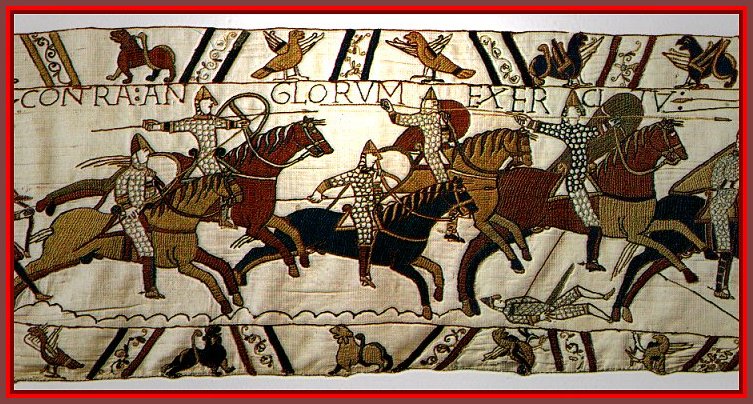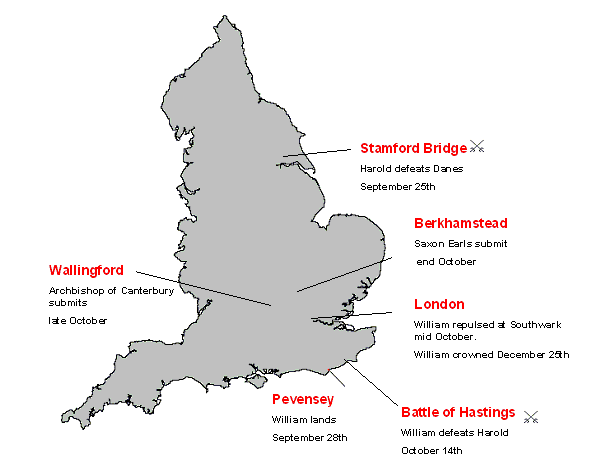Historyguy.com
Norman
Conquest of England (1066-1072)

The Bayeaux Tapestry,
depicting the Norman Invasion of
England
Norman
Conquest of England—(Sept. 28, 1066-1072):
William, the Duke of Normandy, invaded England
in the autumn of 1066, beginning a campaign of conquest
leading to his crowning as the King of England and the
establishment of Norman rule over England.
The
story of The Conquest, as it is known in England, began with
the death of the old king of England, Edward the Confessor.
King Edward had no sons to inherit his throne, a four-way
conflict developed over who would become the next King of
England. The English Witanagemot, the traditional council of
nobles, chose Harold Godwinson as the new
king. The other claimants included; King Harold's
half-brother, Tostig Godwinson, Harald
Hardrada, the King of Norway, and William, Duke of
Normandy, a region in northwest France.
Both
Tostig and Harald Hardrada invaded England to unseat King
Harold, but both attacks failed. The third invasion, by
William of Normandy, proved successful. William landed his
invasion force of nearly 7,000 Normans and assorted European
mercenaries on Sept. 28, 1066 at Pevensey. Following this
landing, he built a base near Hastings.
Harold
marched toward Hastings after defeating and killing Harald
Hardrada and Tostig at Stamford Bridge, a victory which left
his army tired and weakened. On Oct. 14, 1066, the
Anglo-Saxon army of England battled the invading Normans.
The battle ended with Haroald dead and William of Normandy
as the sole living claimant to the throne. William then
marched his forces northward toward London, defeating the
English at Southwark. Journeying toward the capital city,
William received the surrender and submission of several
important Anglo-Saxon nobles, and was crowned as King
William (the First) on December 25, 1066. This ended the
first phase of the Norman Conquest of England.
William
still had to consolidate his power, and over the next
several years, he and his Norman followers defeated several
Anglo-Saxon rebellions, including an invasion by Harold
Godwinson's surviving sons. The Anglo-Saxon rebel, Hereford
the Wake, was defeated at the Battle of Ely Isle in 1070,
and a final campaign in 1072 finally brought northern
England under William's control.
The
Norman Conquest is significant for several reasons. William
was the new King of England, but he was also still the Duke
of Normandy in France, which put him and his successors in
the awkward position of ruling one counrty, while still
serving as a vassal (underling) of another country's ruler,
in this case, the King of France. This dilemma set up
England and France for hundreds of years worth of warfare as
the ruling families of each kingdom battled for control of
both countries. (See the History Guy page on
the
Anglo-French
Wars).
Also,
The Conquest created an ongoing link between the island of
Great Britain (which includes England, Scotland, and Wales)
with the European Continent through the connection of
England and French Normandy. This connection can be seen in
the development of English culture, language, history, and
economics.
See
also: Wars
and Conflicts of Great Britain
Predecessor
Conflicts: (Prior related conflicts )
Tostig's
Rebellion (1066)
Norwegian
(Viking) Invasion of England (1066)
Successor
Conflicts: (Related conflicts occurring at a later
time)
Ongoing
Anglo-Saxon Resistance to Norman rule
Anglo-French
War (1109-1113)
DATES OF
CONFLICT:
BEGAN:
Sept. 28, 1066--This is the date William landed his
forces in England.
ENDED:
1072--William's final campaign which ended formal
Anglo-Saxon resistance in northern England

Outside
Links
Battle
of Fulford--Article
on one of the battles of 1066
Norman
Conquest--Wikipedia
article
Hereford
The Wake--Wikipedia
article
Copyright
© 1998-2020 History Guy Media 07.04.20
"The
History Guy" is a Registered Trademark.
History
Guy SiteMap
|